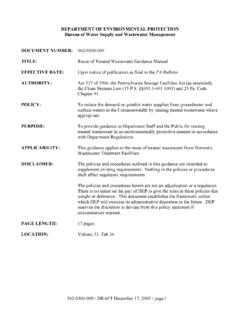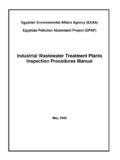Transcription of Greywater - Treatment and Reuse - IOSR Journals
1 IOSR Journal of Mechanical and Civil Engineering (IOSR-JMCE) ISSN: 2278-1684, PP: 20-26 Second International Conference on Emerging Trends in Engineering (SICETE) 20 | Page College of Engineering, Jaysingpur Greywater - Treatment and Reuse J. S. LAMBE , Department of Civil Engineering, College of Engineering, Jaysingpur, 416101, Maharashtra, India R. S. CHOUGULE , Department of Civil Engineering, College of Engineering, Jaysingpur, 416101, Maharashtra, India ABSTRACT: India is facing a water crisis and by 2025 it is estimated that India's population will be suffering from severe water scarcity.
2 Although India occupies only million km2 geographical area which forms of the worlds land area, it supports over 15% of world's population with only 4% of the world's water resources. With increased population growth and development, there is a need to critically look at alternative approaches to ensure water availability. These alternative resources include rainwater and bulk of water used in household will emerge as grey water and contain some minerals, organic waste materials dissolved and suspended in it. When this is allowed to flow out this will join the sewage and bacteriologically contaminated, resulting in a sewage stream.
3 It is possible to intercept this grey water, at the household level, treat it so that it can be recycled for garden washing and flushing purposes. Keywords: Greywater , sources, Treatment , recycle and Reuse . 1. INTRODUCTION Greywater is specifically washwater. That is, bath, dish, and laundry water excluding toilet wastes and free of garbage-grinder properly managed, Greywater can be a valuable resource which horticultural and agricultural growers as well as home gardeners can benefit from. It can also be valuable to landscape planners, builders, developers and contractors because of the design and landscaping advantages of on-site Greywater Treatment /management.
4 It is, after all, the same phosphorous, potassium and nitrogen making Greywater a source of pollution for lakes, rivers and ground water which are excellent nutrient sources for vegetation when this particular form of wastewater is made available for irrigation. 2. COMPOSITION OF Greywater Greywater from Bathroom Water used in hand washing and bathing generates around 50-60% of total Greywater and is considered to be the least contaminated type of Greywater . Common chemical contaminants include soap, shampoo, hair dye, toothpaste and cleaning products. It also has some faecal contamination (and the associated bacteria and viruses) through body washing.
5 Greywater from Cloth Washing Water used in cloth washing generates around 25-35% of total Greywater . Wastewater from the cloth washing varies in quality from wash water to rinse water to second rinse water. Greywater generated due to cloth washing can have faecal contamination with the associated pathogens and parasites such as bacteria. Greywater from Kitchen Kitchen Greywater contributes about 10% of the total Greywater volume. It is contaminated with food particles, oils, fats and other wastes. It readily promotes and supports the growth of micro-organisms. Kitchen Greywater also contains chemical pollutants such as detergents and cleaning agents which are alkaline in nature and contain various chemicals.
6 Therefore kitchen wastewater may not be well suited for Reuse in all types of Greywater systems. Greywater - Treatment and Reuse Second International Conference on Emerging Trends in Engineering (SICETE) 21 | Page College of Engineering, Jaysingpur 3. AVERAGE POLLUTANTS LOADING Average Pollutants Loading (grams per person per day - ) Type Greywater Grey + Black combined BOD5 34 71 SS 18 70 Tot. N Tot P Tot P* * No Phosphorous detergent 4. HOW MUCH Greywater DO YOU PRODUCE? According to state and local authorities we each use about 140 litres of water per day for cleaning and washing - Greywater .
7 The table below lists the expected volume in litres from each Greywater source. Combined Wastewater Sources of waste water and its type 5. Greywater Treatment OPTIONS Greywater Reuse methods can range from low cost methods such as the manual bucketing of Greywater from the outlet of bathroom, to primary Treatment methods that coarsely screen oils, greases and solids from the Greywater before irrigation via small trench systems, to more expensive secondary Treatment systems that treat and disinfect the Greywater to a high standard before using for irrigation. The choice of system will depend on a number of factors including whether a new system is being installed or a disused wastewater system is being converted Greywater - Treatment and Reuse Second International Conference on Emerging Trends in Engineering (SICETE) 22 | Page College of Engineering, Jaysingpur because the household has been connected to sewer.
8 6. COMPONENTS OF Greywater Treatment SYSTEMS A number of technologies have been applied for Greywater Treatment worldwide varying in both complexity and performance. The following in general Greywater systems considered :- a)Primary Treatment - pre- Treatment to secondary Treatment :- 1. Screening b)Secondary filtration filtration Greywater Treatment Scheme Raw Greywater Primary Treatment (Screening, Equalization tank)-Secondary Treatment -I (Gravel filter, Sand filter) Secondary Treatment -II Broken brick,Charcoal, Chorination)-Treated Greywater Treatment Units and Functions Unit of Treatment system Removal 1.
9 Screen Floating matter, Greywater - Treatment and Reuse Second International Conference on Emerging Trends in Engineering (SICETE) 23 | Page College of Engineering, Jaysingpur suspended matter 2. Junction chamber Odour, some of settleable solids 3. Equalization Tank Settleable solids (Holding) 4. Horizontal Roughing Turbidity, suspended Filter solids, some amount of BOD 5. Slow Sand Filter Colour, bacteria, suspended solids and some amount of BOD 6. Disinfection Bacteria, odour Aerobic Pre- Treatment -- suitable for showers, hand-washing and laundry* water Treatment .
10 Anaerobic to aerobic Treatment 7. HOUSEHOLD LEVEL Greywater Treatment AND Reuse SYSTEM In water scarce areas, with specific Treatment the Greywater can be cleaned and reused not only for gardening but for other use also. Technological process Greywater Treatment process at the household level mainly involves screening (grease and silt removal), soap froth removal, equalization and filtration. Flow diagram of household based Greywater Treatment system is shown Greywater - Treatment and Reuse Second International Conference on Emerging Trends in Engineering (SICETE) 24 | Page College of Engineering, Jaysingpur below: Greywater Treatment for Reuse in household 1.











